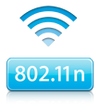
IEEE 802.11 is a set of wireless local area network (WLAN) specifications standardized by the Institute of Electrical and Electronics Engineers. It is the foundation of Wi-Fi technology implemented by Apple under the AirPort brand.[1]
Specifications[]
802.11a[]
A radio-based LAN protocol which speaks OFDM at 5GHz, one of the two wi-fi protocols at the time.[2]
802.11b[]

An IEEE wireless local area network protocol which speaks DSSS at 2.4GHz. 802.11b is one of the two wi-fi protocols. It operates at 11 megabits per second (Mbps).[2] It was introduced by Apple Computer in the original AirPort card for the iBook G3 in 1999.[3]
802.11g[]
An IEEE wireless local area network protocol that was expected to be approved in June 2003. 802.11g offers wireless transmission over relatively short distances at up to 54 megabits per second (Mbps). 802.11g operates in the 2.4GHz range and is backwards compatible with 802.11b (11 Mbps Wi-Fi).[2] It was adopted by Apple in the original AirPort Extreme and Express in June 2004.[4][5]

802.11n[]
802.11n offers speeds of up to 450 Mbps 2.4 or 5GHz frequencies. It was first adopted in draft form by Apple in the 1st-generation AirPort Extreme 802.11n in January 2007.[6]

802.11ac[]
802.11ac, retroactively branded as "Wi-Fi 5",[7] specifies up to 3 simultaneous streams of 450 Mbps each in the 5GHz range, offering a potential maximum of 1.3 Gbps. It was first adopted in draft form by Apple in the AirPort Extreme 802.11ac in June 2013.[8][9]
802.11ax[]
802.11ax, branded as "Wi-Fi 6", offers speeds of up to 1.3 Gbps at 2.4 or 5GHz frequencies with improved efficiency in crowded environments.[7] It was introduced in draft form by Apple in the iPhone 11 series in September 2019.[10] In April 2020, the Federal Communications Commission (FCC) voted unanimously to open up the 6GHz band for public use, quadrupling the potential ammount of bandwidth, branded as "Wi-Fi 6E". However, new routers will be required to support the new frequencies.[11]
Device support[]
All current Apple devices support up to 802.11ac (Wi-Fi 5) protocols. Devices that support 802.11ax (Wi-Fi 6) include:
- iPad Air (4th generation) and later (since October 2020)
- iPad mini (6th generation) and later (since September 2021)
- iPad Pro (4th generation) and later (since March 2020)
- iPhone 11 series and later (since September 2019)
- MacBook Air (M1) and later (since November 2020)
- MacBook Pro (M1) and later (since November 2020)
- Mac Mini (M1) and later (since November 2020)
In October 2022, the 6th-generation iPad Pro became the first Apple device to support Wi-Fi 6E.[12]
References[]
- ↑ AirPort Wireless Communications FAQ, Apple Computer. Archived 1999-10-13.
- ↑ 2.0 2.1 2.2 802.11 at the Free On-Line Dictionary Of Computing. Accessed 2021-03-08.
- ↑ Introducing AirPort, Apple Computer. Archived 1999-10-05.
- ↑ AirPort Extreme - Technical Specifications, Apple Computer. 2004-06-07. Archived 2004-06-08.
- ↑ Introducing AirPort Express with AirTunes., Apple Computer. Archived 2004-06-07.
- ↑ AirPort Extreme 802.11n (1st Generation) - Technical Specifications, Apple Inc. 2016-04-06.
- ↑ 7.0 7.1 What is 802.11ax (Wi-Fi 6), and what will it mean for 802.11ac by Neal Weinberg, Network World. 2018-02-27.
- ↑ The all-new AirPort Extreme, Apple Inc. Archived 2013-06-11.
- ↑ AirPort Extreme 802.11ac - Technical Specifications, Apple Inc. 2017-05-23.
- ↑ iPhone 11 - Technical Specifications, Apple Inc. Accessed 2021-03-07.
- ↑ What Is Wi-Fi 6E? by Jerry Jackson, PC Magazine. 2021-10-07.
- ↑ Apple introduces next-generation iPad Pro, supercharged by the M2 chip, Apple Inc. 2022-10-18.
External links[]
- IEEE 802.11 Wireless Local Area Networks official site of the working group for WLAN standards
- Official IEEE 802.11 Working Group Project Timelines (2021-03-05)
- IEEE 802.11 at Wikipedia
